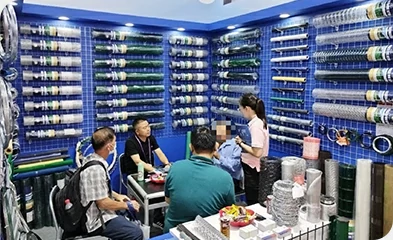 TEL:
+86-13102802206
TEL:
+86-13102802206
 Email:
fencenetting@china.com
Email:
fencenetting@china.com
 Language
Language
 TEL:
+86-13102802206
TEL:
+86-13102802206
 Email:
fencenetting@china.com
Email:
fencenetting@china.com
 Language
Language


The Versatility of Iron Wire A Key Material in Modern Industry
Iron wire, a seemingly simple material, plays an essential role in a myriad of applications across various industries. Its strength, durability, and versatility make it a staple in construction, manufacturing, and even arts and crafts. This article explores the importance of iron wire, its characteristics, and the diverse ways it is utilized today.
Iron wire is produced through a process of drawing iron or steel to achieve the desired gauge or thickness. This process enhances the mechanical properties of the wire, making it robust enough to withstand significant tension without breaking. Its high tensile strength ensures that it can be used in both structural and non-structural applications. As a result, iron wire is often found supporting buildings, bridges, and other infrastructures, providing structural integrity and safety.
In the construction industry, iron wire serves as a fundamental component in various forms of reinforcement. For instance, it is commonly used in the production of reinforced concrete. Steel reinforcement bars (rebar), often bundled with iron wire, are embedded in concrete structures to improve their tensile strength. This combination allows for the creation of durable and resilient buildings capable of withstanding natural forces such as earthquakes and heavy winds. Furthermore, iron wire is used in fencing, providing security and boundary definitions for residential and commercial properties.

Beyond construction, iron wire is integral to the manufacturing sector. It is utilized in the production of a wide range of products, from heavy machinery to simple household items. The automotive industry, for example, uses iron wire in the production of various components, including springs, tension bars, and even in the securing of parts during assembly. Additionally, iron wire is essential in the creation of wire products such as nails, hooks, and fasteners, which are ubiquitous in everyday life.
The agricultural sector also benefits from the versatility of iron wire. It is commonly used for fencing, ensuring the safety and containment of livestock. The durability of iron wire makes it an excellent choice for building strong and long-lasting enclosures that can withstand the elements. This application not only protects animals but also aids in the management of agricultural land.
Interestingly, iron wire has found its place in the world of art and craft. Artists and artisans often use iron wire to create intricate sculptures, installations, and decorative pieces. Its malleability allows for unique designs and structures, adding an industrial aesthetic to artistic creations. Moreover, the ease of manipulation and availability of iron wire make it an accessible medium for both professional artists and hobbyists alike.
In conclusion, iron wire may appear to be a humble material, but its contributions to modern society are substantial. From construction and manufacturing to agriculture and the arts, iron wire's strength and versatility are indispensable. As industries evolve and innovate, iron wire will undoubtedly continue to play a pivotal role in supporting various activities and enhancing our daily lives. Its enduring nature ensures that it remains a critical material in the pursuit of progress and creativity.